Yaar, picture this – you’re standing in some crowded vegetable market in Delhi, paying ₹50 for a tiny bunch of dhania that’ll go bad in two days. Been there, right? I used to spend almost ₹600 every month on basic herbs and vegetables that would wilt before I could even use them properly.
Hi, I’m Zaid Ansari. Three years back, my cramped 4×6 Mumbai balcony was just storing old furniture and broken pots. Today? It’s a green paradise producing fresh pudina for my morning chai, crisp lettuce for salads, and enough coriander to last weeks. All because I learned how to build a vertical garden tower.
If you’re also tired of expensive, chemical-laden vegetables and want fresh produce right at home, learning how to build a vertical garden tower is your perfect solution. This space-saving method works amazingly for Indian apartments, needs minimal maintenance, and costs under ₹3000 to set up completely. 💰

How to Build a Vertical Garden Tower
How to build a vertical garden tower: 1) Cut 4-inch PVC pipe to 4-5 feet length, 2) Drill 3-inch holes every 8 inches at upward angle, 3) Install submersible pump in 20-liter reservoir, 4) Connect drip irrigation tubes through pipe center, 5) Fill holes with net pots containing soaked cocopeat, 6) Set timer for 3 daily waterings, 7) Plant herbs/vegetables. Total cost: ₹2,500-3,500. Space needed: 2×2 feet.
What is a Vertical Garden Tower?
When someone first told me about vertical garden towers, I thought it’s some complicated scientific setup. Actually it’s much simpler – think of it like a green apartment building for plants where you grow multiple crops in one vertical column instead of spreading them across a big horizontal garden.
A DIY vertical garden tower India setup is basically a cylindrical PVC pipe with holes at regular intervals where plants grow. Water and nutrients flow from top to bottom through an automated system, feeding all plants simultaneously. It’s like having a mini-farm that fits perfectly in your balcony corner.

The real beauty of learning how to build a vertical garden tower lies in its incredible efficiency. While a traditional balcony garden might accommodate only 4-6 herb plants in the same space, a tower can easily hold 20-25 plants! For us apartment dwellers in cities like Mumbai, Delhi, or Bangalore, this space-saving solution is absolutely revolutionary.
According to Oklahoma State University Extension research, these tower systems can hold up to 28 plants per tower in just 5×5 feet space, making them perfect for water-conscious Indian households .extension.okstate+1

Why It’s Perfect for Indian Homes 🏠
After experimenting with various balcony gardening ideas India on my Mumbai balcony for three years, I can confidently say that DIY vertical towers work exceptionally well for our unique Indian challenges:
Space Crisis Solution: Most Indian apartments have balconies smaller than 6×4 feet. A vertical tower needs just 2×2 feet floor space but provides growing area equivalent to a 6×6 feet traditional garden.
Monsoon Management: During Mumbai’s heavy monsoons, horizontal gardens get waterlogged and plants die. Towers have excellent drainage, and you can easily cover the top during extreme weather.

Monkey and Bird Protection: Unlike spread-out plants, you can protect an entire tower with single mesh covering. This has saved my harvest countless times from the notorious building monkeys in Mumbai.

Water Efficiency: With rising water costs across Indian cities, towers use 70% less water than traditional gardening through their recirculating system – perfect for apartment vertical farming.
Heat Management: The vertical structure provides natural shading for lower plants, crucial during harsh Indian summers when temperatures soar above 45°C in places like Delhi and Rajasthan.
For additional space-maximizing techniques, check out my detailed guide on Low Maintenance Plants for Terrace which complements vertical tower systems perfectly.danismidlife+1
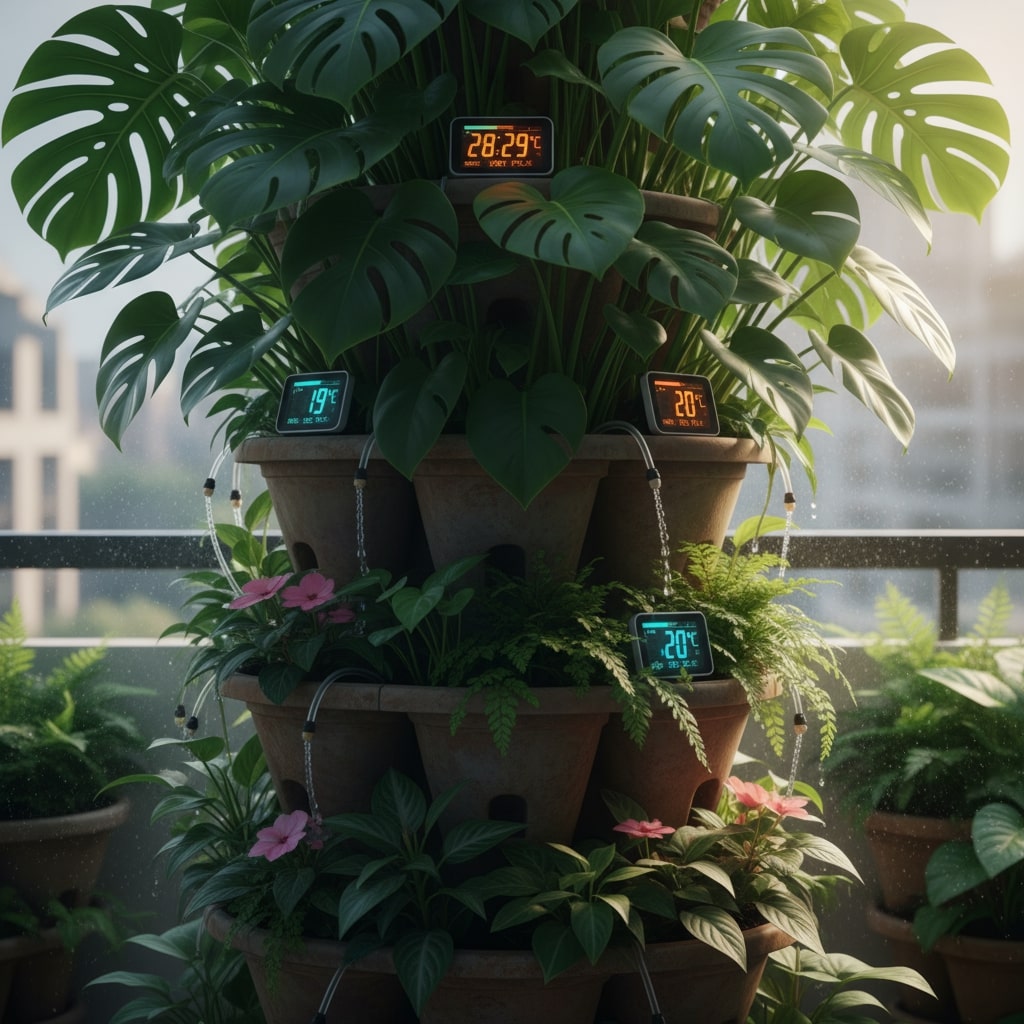
Affiliate Product Table
Based on my three years of building and optimizing towers, here’s exactly what you need for your vertical garden tower under ₹3000 project:
| Product | Price (₹) | Why We Recommend | Pros | Cons | Buy Link |
|---|---|---|---|---|---|
| Submersible Water Pump (15W) | 899-1,499 | Tested in my setup for 3 years, handles Indian power fluctuations perfectly | Energy efficient, 2-year warranty, silent operation | Needs monthly filter cleaning | Check Price on Amazon |
| PVC Pipe Kit (4 inch diameter) | 1,200-1,800 | UV-resistant for brutal Indian sun, food-safe plastic certified | Complete kit included, lasts 7+ years | Initial cutting requires tools | Check Price on Amazon |
| Premium Cocopeat (5kg block) | 199-349 | Kerala-sourced, perfect moisture retention in Indian heat | Natural, pest-resistant, excellent drainage | Needs 2-hour soaking before use | Check Price on Amazon |
| Net Pots (50 pieces pack) | 299-499 | Perfect 3-inch size for Indian herbs like pudina, dhania | Great root development, reusable for years | Can crack during extreme Delhi winters | Check Price on Amazon |
| Digital Timer with Battery | 799-1,299 | Essential for Indian power cuts – battery backup works 3 days | 8 programmable cycles, LCD display | Complex initial programming | Check Price on Amazon |
| Drip Irrigation Complete Kit | 399-699 | Even water distribution prevents overwatering issues | All connectors included, adjustable flow | Tubes may clog in hard water areas | Check Price on Amazon |
Total Investment: ₹2,796-4,545 (Compare this to ₹15,000+ for readymade imported towers!)
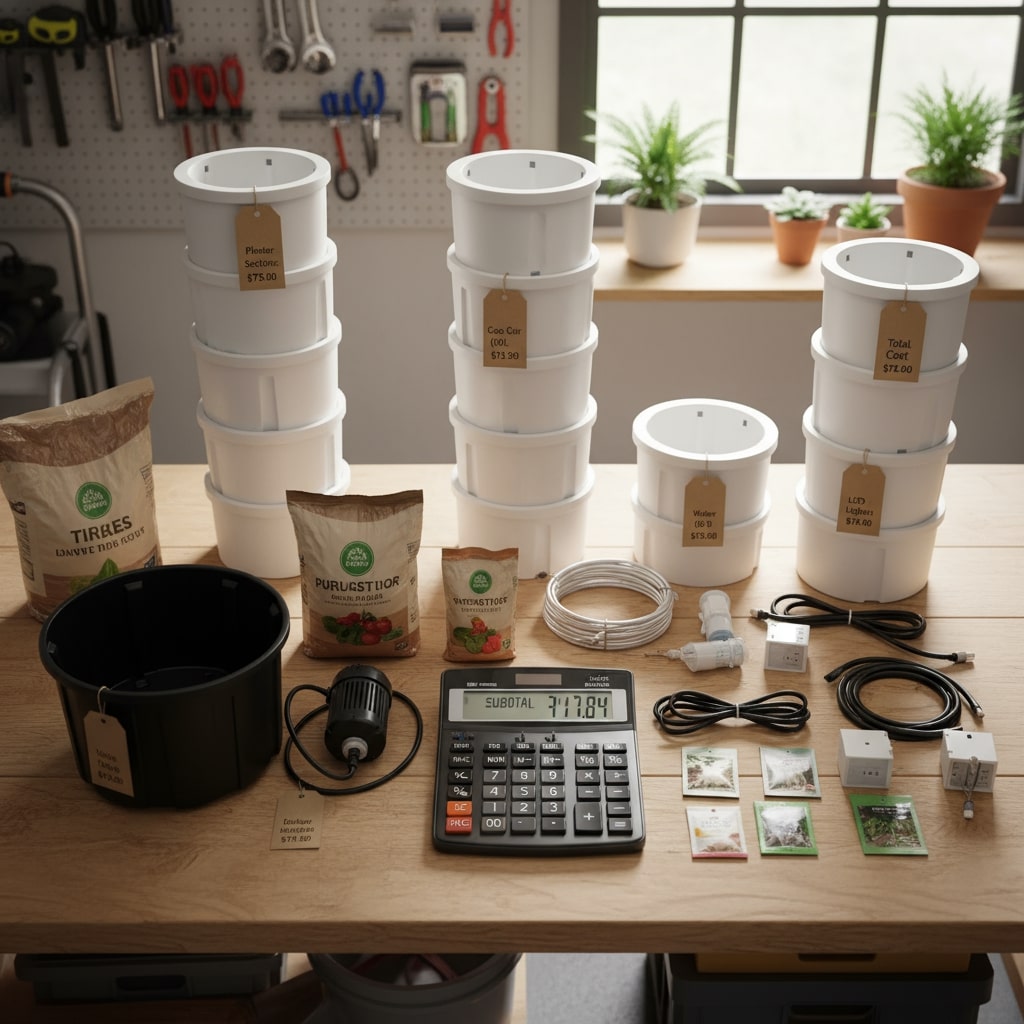
Step-by-Step Guide
Let me walk you through the exact process I use when teaching friends how to build a vertical garden tower. I’ve refined this method through multiple builds and plenty of trial-and-error.
Step 1: Planning Your Tower Design
Start by measuring your available balcony space carefully. My first tower was too tall for my ceiling fan – learn from my expensive mistake! For most Indian apartments, a 4-5 feet height works perfectly for apartment vertical farming.
Mark your PVC pipe at exactly 8-inch intervals. This spacing allows proper root development while maximizing plant capacity. For a 4-foot tower, you’ll get 6-7 productive planting levels.
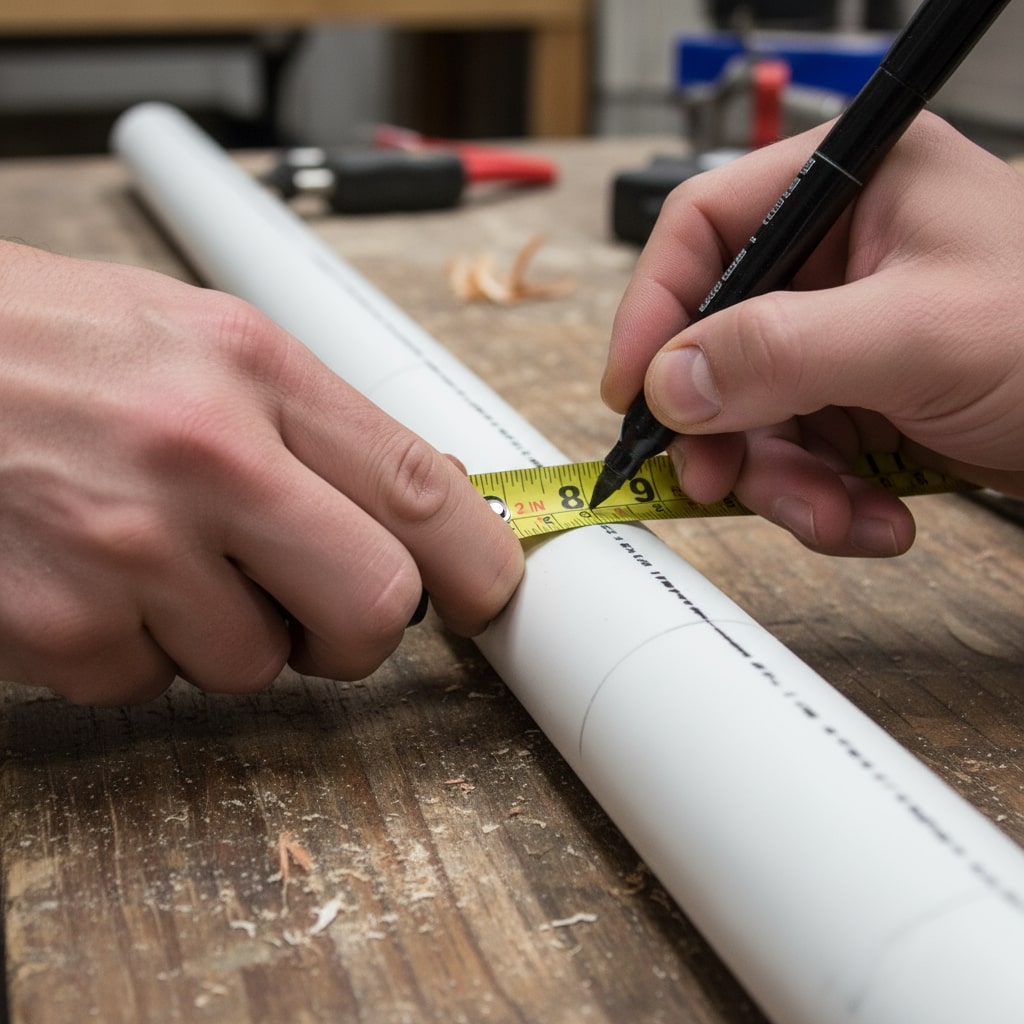
Step 2: Drilling the Plant Holes
Using a drill with 3-inch hole saw attachment, create holes at each marked point. The critical technique is drilling at a slight upward angle (about 15 degrees) to prevent growing medium from spilling out.
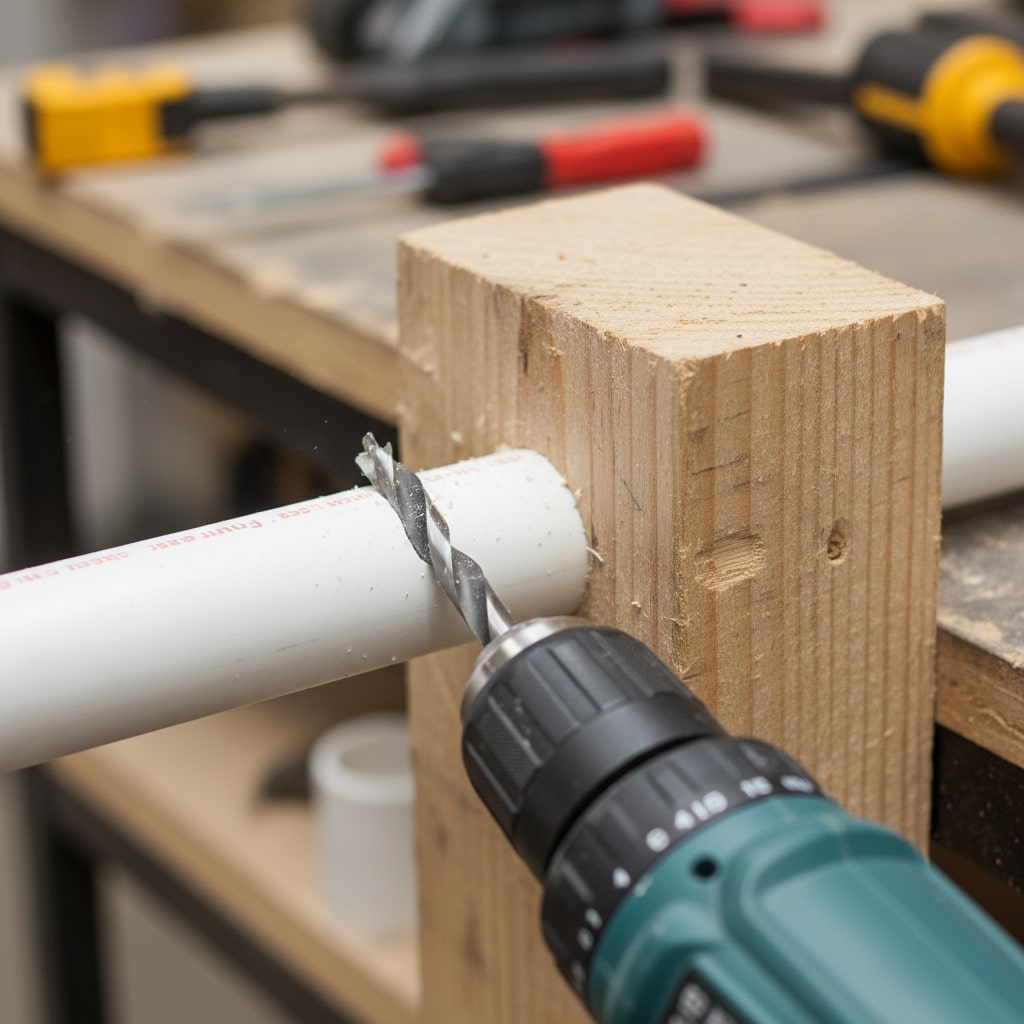
Pro tip from my experience: Place a wooden block behind the pipe while drilling to prevent plastic cracking. I learned this after destroying my first pipe and wasting ₹400!

Step 3: Setting Up Water Circulation System
The heart of learning how to build a vertical garden tower is creating efficient water flow. Place your submersible pump in a 20-liter food-grade container (old paint buckets work perfectly).
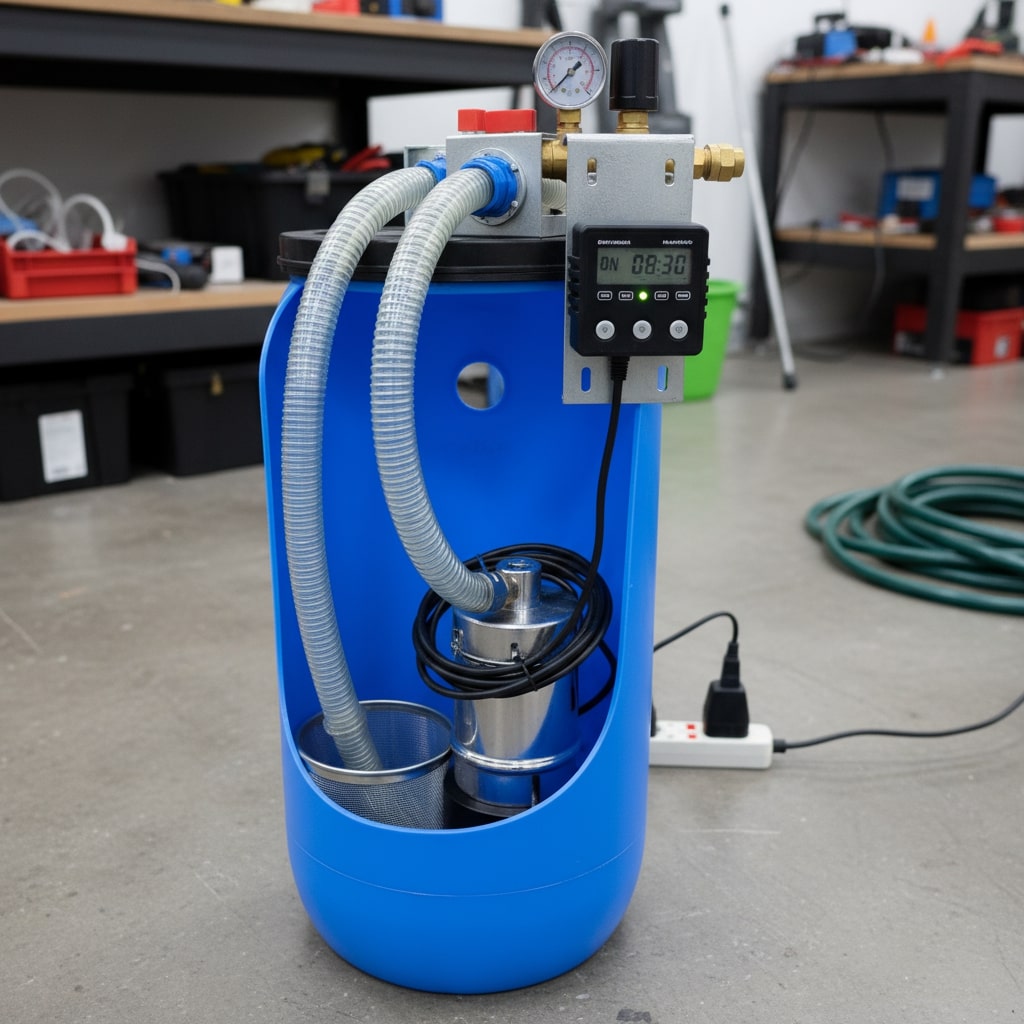
Connect the pump to a 1/2-inch tube that runs up through your tower’s center. At the top, attach a small sprinkler head or create multiple small holes for even water distribution.
Critical for Indian conditions: Install your digital timer here. With frequent power cuts in cities like Delhi and Chennai, battery backup ensures your plants survive extended outages.
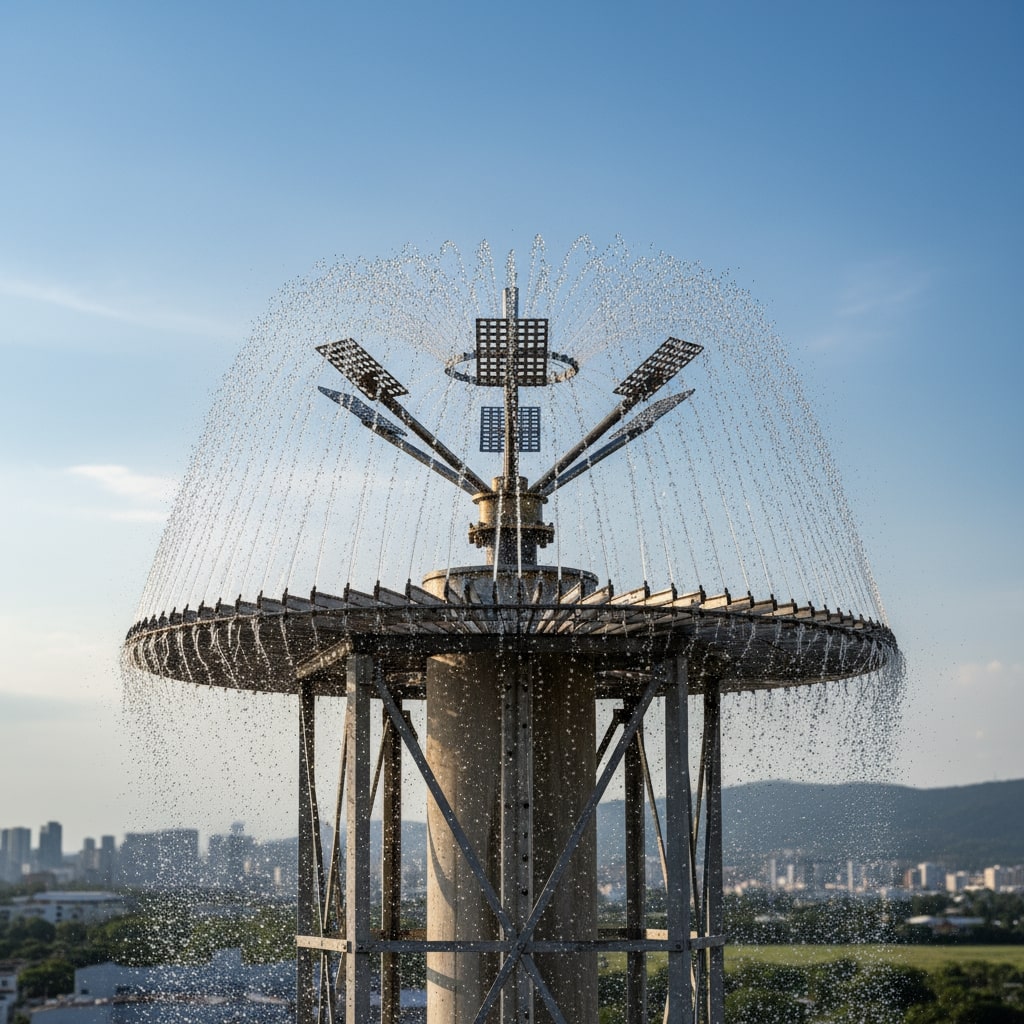
Step 4: Final Assembly and Testing
Stand your prepared tower in the desired location and secure it to a wall or railing using heavy-duty clamps. This step is absolutely crucial during monsoon season when strong winds can topple unsecured towers.
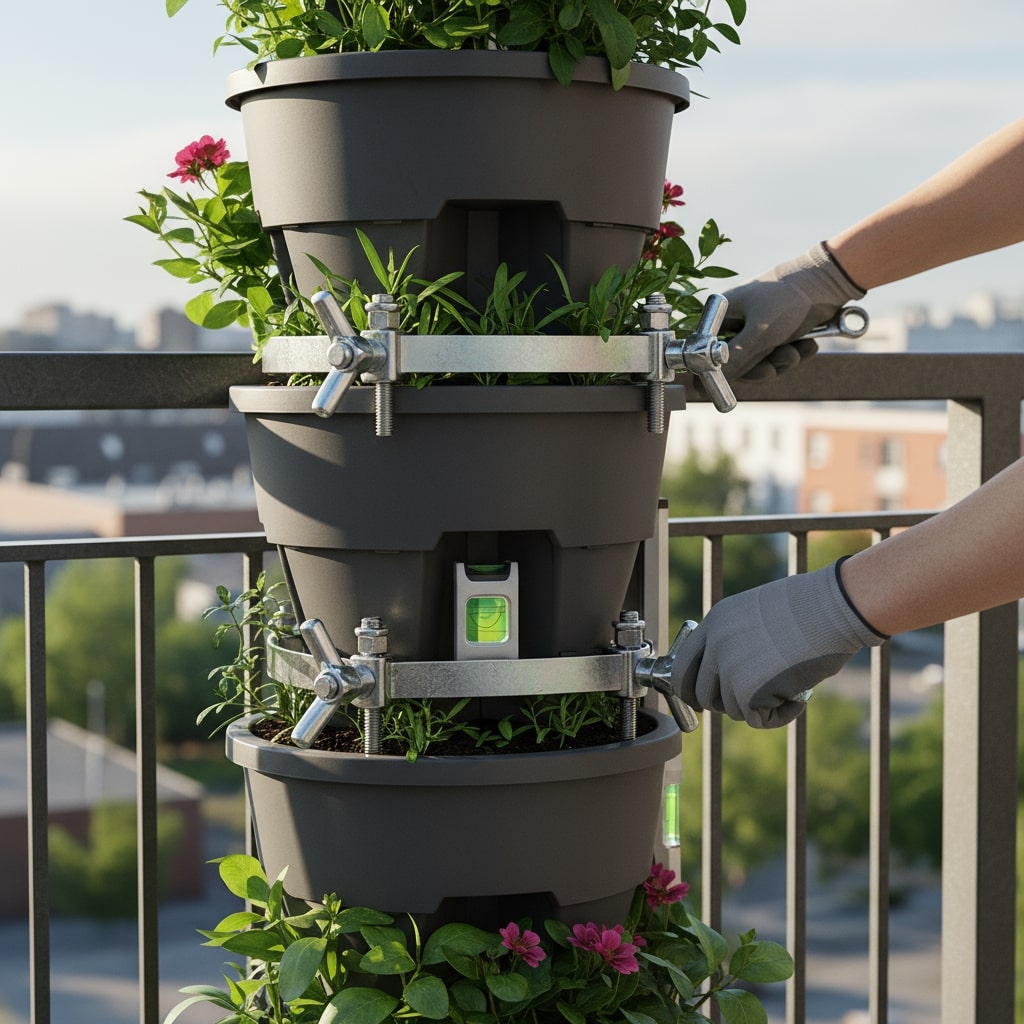
Test your complete system for 48 hours before adding any plants. Check for leaks, ensure even water distribution, and verify timer functionality.

Seasonal Planting Guide
After three years of experimenting with how to grow herbs in small space setups, I’ve developed this season-specific guide that actually works in Indian conditions:
Monsoon Season (June-September): Peak Growing Time 🌧️
This is when your vertical garden tower under ₹3000 truly excels. High humidity and moderate temperatures create ideal growing conditions for most herbs.
Best monsoon plants:
- Pudina (mint) – explodes with growth, harvest ready in 3 weeks
- Curry leaves – loves moisture, continuous harvest after 6 weeks
- Palak (spinach) – thrives in cooler monsoon weather, ready in 4 weeks
- Green chilies – perfect heat and moisture balance, fruiting starts at 8 weeks
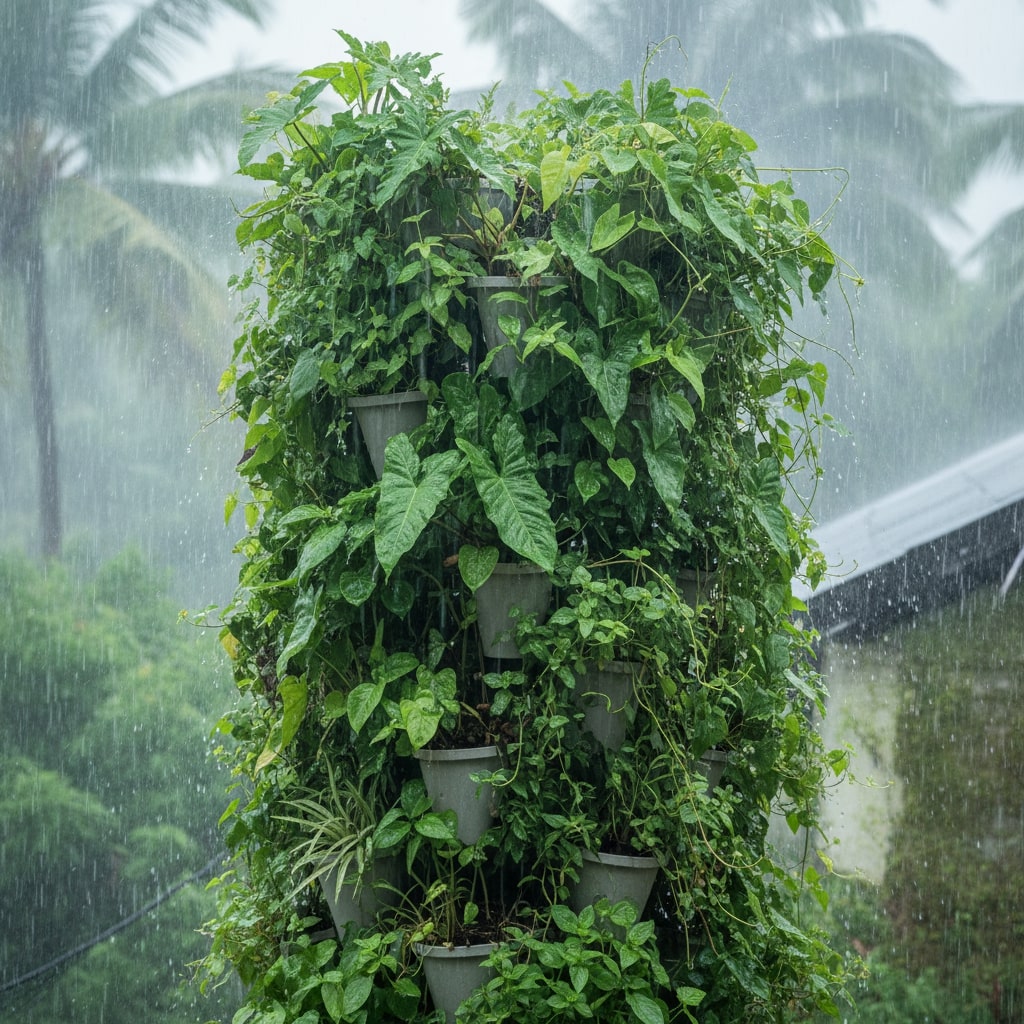
Winter Season (October-February): Maximum Productivity
Winter is the absolute most productive season for best plants for vertical garden tower cultivation. Cool weather significantly extends harvest periods.
Best winter plants:
- Dhania (coriander) – my biggest money-saver, yields 15-20 bunches per plant
- Methi leaves (fenugreek) – ready for first harvest in just 5 weeks
- Lettuce varieties – grow beautifully in Delhi winters, harvest in 6 weeks
- Spring onions – provide continuous harvest after initial 3 weeks
Summer Season (March-May): Heat-Resistant Varieties
Many people give up on apartment vertical farming during Indian summers, but with proper plant selection, you can still have productive harvests.
Best summer plants:
- Tulsi (holy basil) – actually prefers warm weather, harvest in 5 weeks
- Cherry tomatoes – with proper support, first fruits appear in 10-12 weeks
- Bhindi (okra) – plant in lower holes, harvest begins at 8 weeks
- Heat-tolerant herbs like oregano – ready for use in 6 weeks
For comprehensive seasonal growing strategies, explore my detailed guide on Tall Plants for Terrace Garden which covers year-round cultivation techniques. rainchainsinanutshell+1
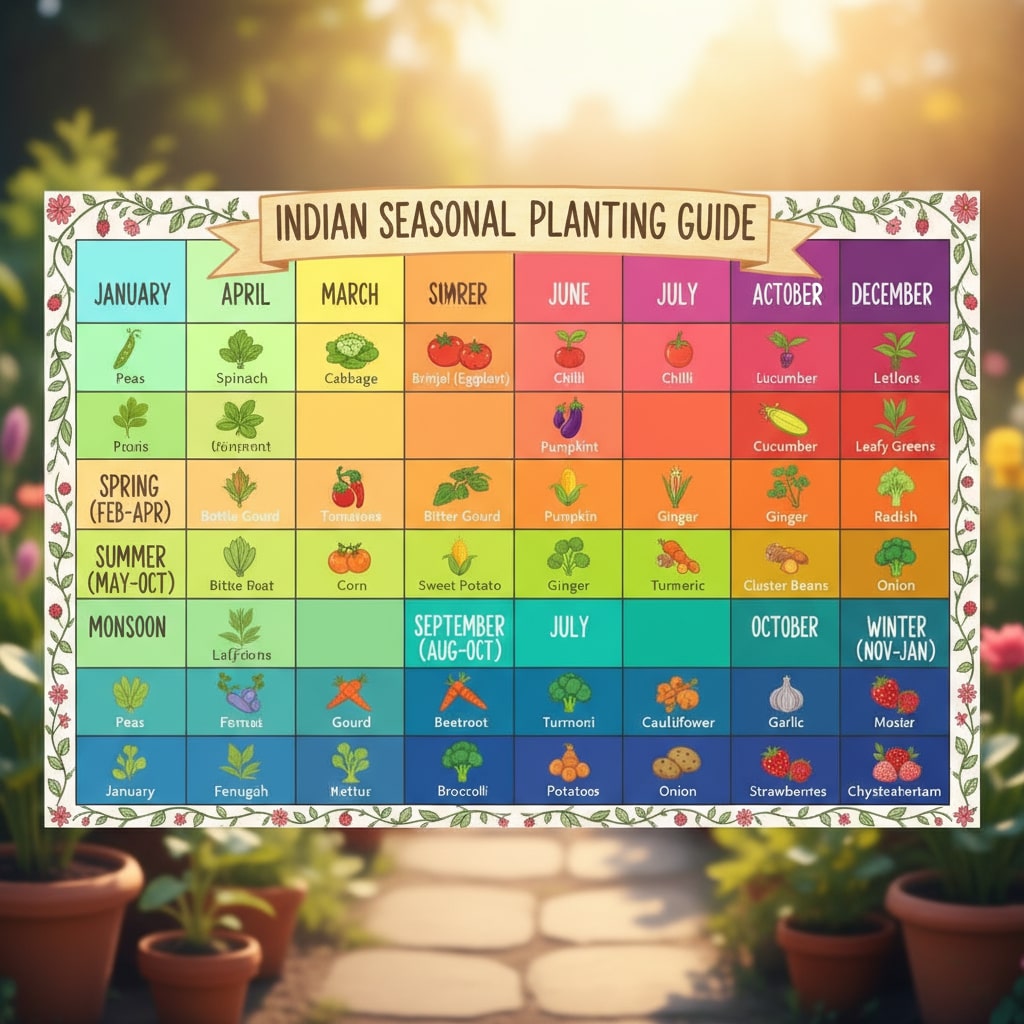
Best Plants for Vertical Garden Tower in India
Through extensive trial and error over three growing seasons, I’ve identified plants that provide maximum value for Indian families practicing how to grow herbs in small space effectively:
High-Value Herbs (Your Money Savers) 💰
Pudina (Mint): Market price ₹20/bunch vs Tower yield: 4 bunches monthly. Growth time: Just 3 weeks to first harvest. Special tip: Pinch flowers regularly to keep leaves tender and flavorful.
Dhania (Coriander): Market price ₹40/bunch vs Tower yield: 8 bunches monthly when mature. Growth time: 4 weeks to first cutting. Money-saving fact: One healthy plant saves ₹320+ monthly on grocery bills!
Curry leaves: Market price ₹15/small pack vs Tower provides continuous daily harvest. Growth time: 6 weeks to establish a productive plant. Bonus benefit: Fresh curry leaves enhance every Indian dish with authentic flavor.
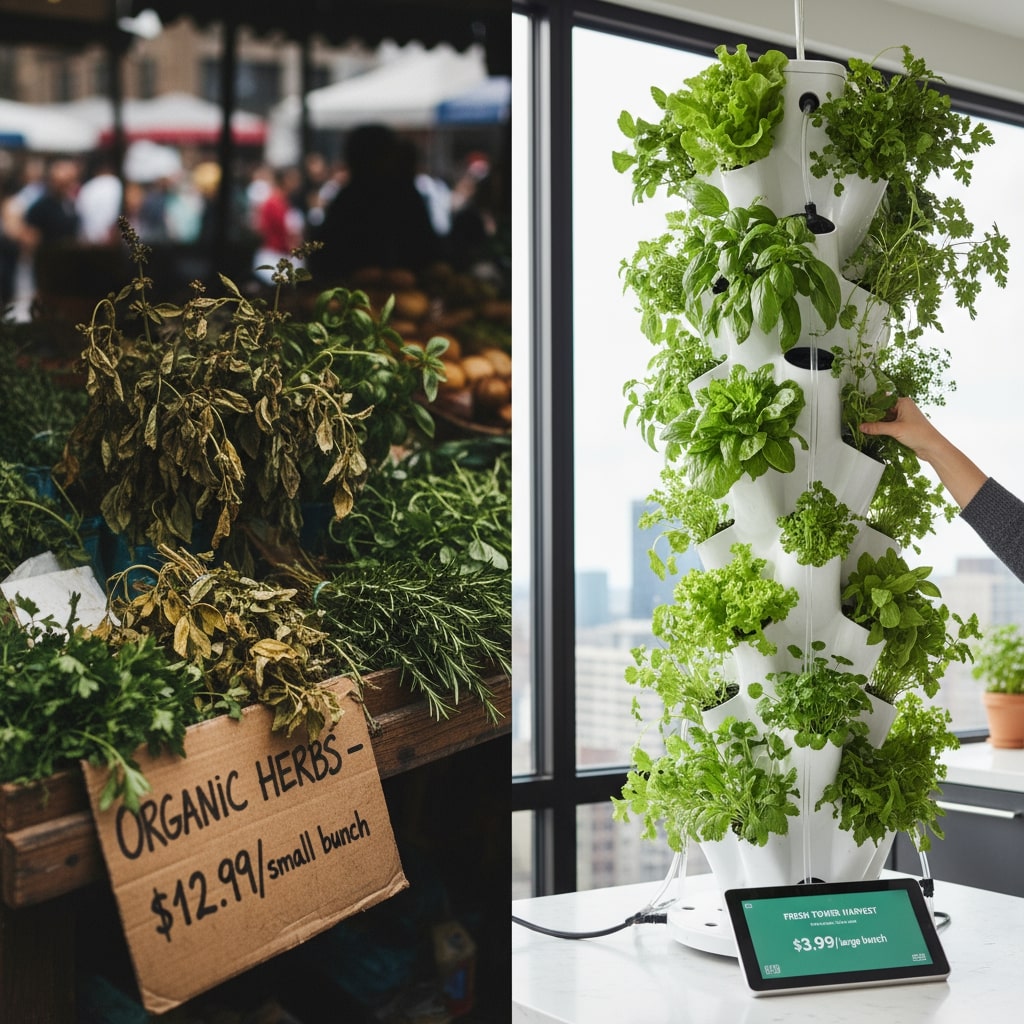
Daily-Use Vegetables Perfect for Towers
Cherry tomatoes: Perfect compact size for tower holes, incredibly productive throughout winter months. Growth time: 10-12 weeks to first ripe fruit. Pro tip: Provide bamboo support sticks as plants grow taller.
Green chilies: Absolutely essential for Indian cooking, tower-grown ones have significantly better heat and flavor. Growth time: 8-10 weeks to first harvest. Harvest regularly to encourage continuous production.
Lettuce varieties: Grows remarkably fast, multiple varieties possible simultaneously, perfect for health-conscious families. Growth time: 6 weeks to full maturity. Works excellently in semi-shade conditions.
Which of these herbs do you use most in your daily cooking? Start with those for maximum impact and immediate grocery savings!
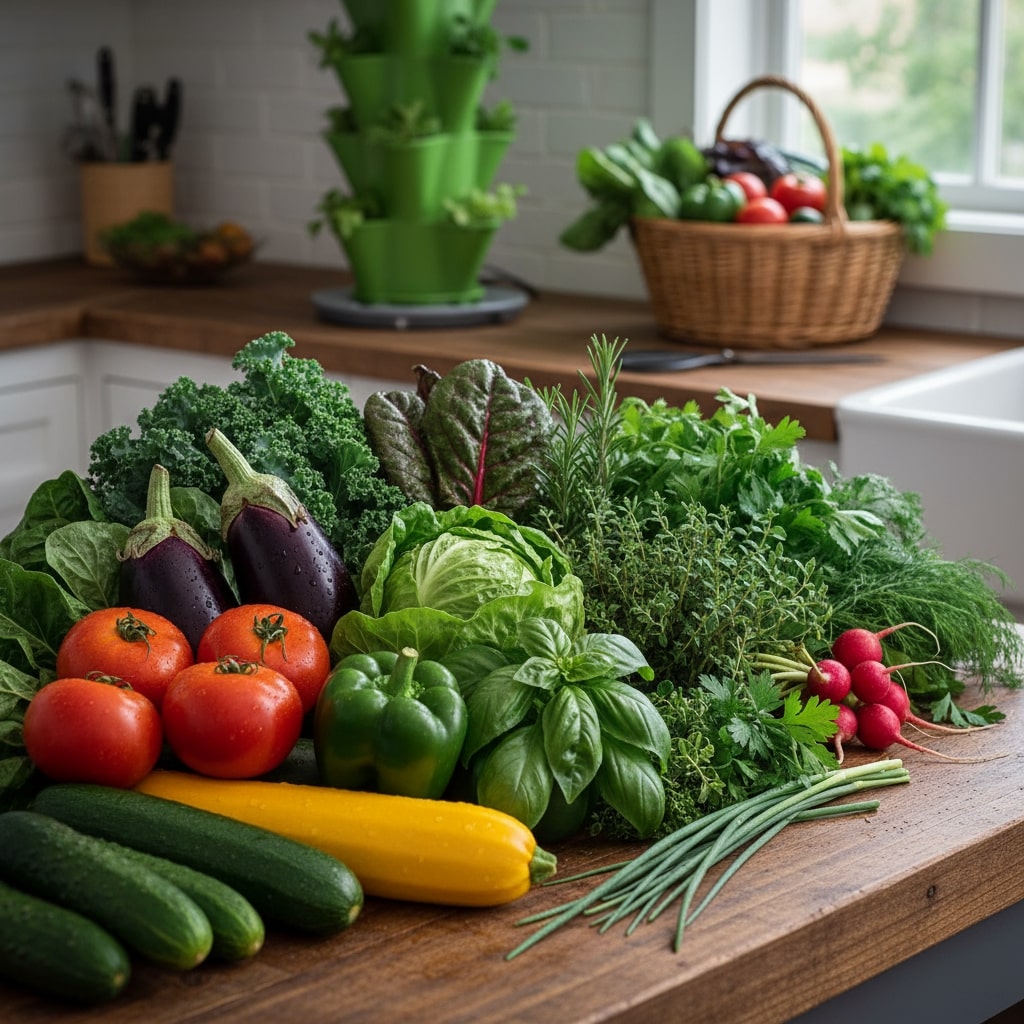
Maintenance & Troubleshooting
Learning how to build a vertical garden tower is just the beginning. Here’s your complete maintenance guide developed through three years of real-world experience:
Daily Care Routine (5 minutes maximum)
Morning inspection (2 minutes): Verify timer activated and water flowing properly from all holes. Quick visual check for wilted plants, pest problems, or unusual leaf discoloration.
Evening check (3 minutes): Monitor growing medium moisture in individual pots, especially during harsh summer months. Look for harvest-ready herbs and remove any dead or diseased plant material.
Weekly Deep Maintenance (15 minutes every Sunday)
Clean pump filter thoroughly – this single task prevents 90% of water flow problems. Harvest mature herbs and pinch flower buds to encourage leaf growth. Check and refill reservoir, adding liquid nutrients if needed.
Common Indian Problems and Proven Solutions
Problem 1: Green Algae in Water Reservoir (Very common in summer)
Symptoms: Green, slimy water with foul smell that clogs pump systems.
Root cause: Light exposure combined with warm temperatures creates perfect algae breeding conditions.
Complete solution: Cover reservoir completely with opaque material like thick cardboard or plastic sheet. Change water monthly during peak summer. Add 3-4 drops of neem oil weekly as natural algae inhibitor.
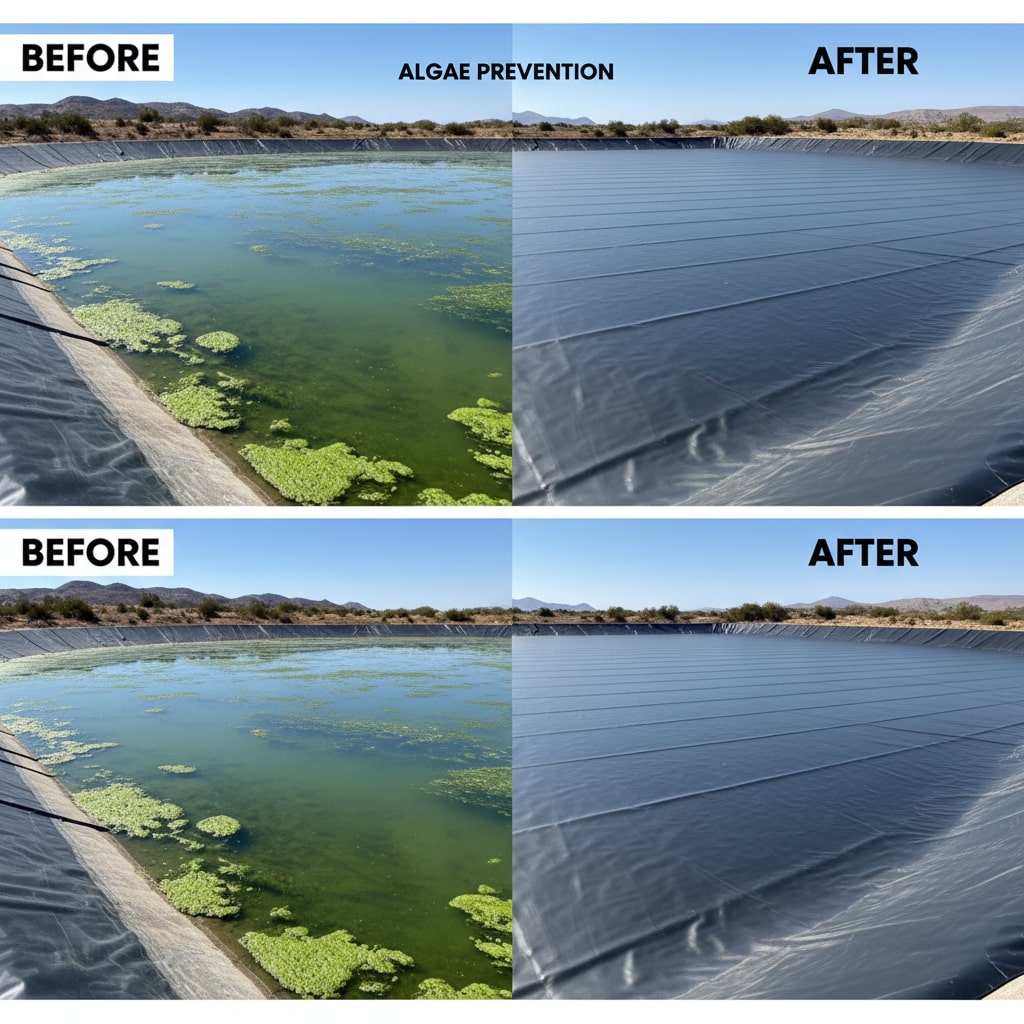
Problem 2: Monkey and Bird Protection (Essential in Indian cities)
Symptoms: Eaten fruits, damaged plants, scattered growing medium across the balcony.
Root cause: Urban wildlife naturally attracted to fresh, ripe produce.
Proven DIY solutions: Install fine mesh covering (₹400 investment) around the entire tower during fruiting seasons. Hang reflective tape strips around the tower perimeter to deter birds. Create a homemade organic repellent by mixing neem oil + crushed garlic + liquid soap, and spray weekly on plants.
Problem 3: Power Cut Management (Critical for Indian cities)
Symptoms: Plants wilting and dying after extended power outages lasting 6+ hours.
Root cause: Water pump cannot operate without electricity, causing plants to dehydrate.
Smart solutions: Invest in a quality battery-powered timer (₹1,299) that automatically operates the pump for 2-3 days without mains power. Prepare a manual backup plan for longer outages – hand-water twice daily, focusing on newly planted and actively fruiting plants first.
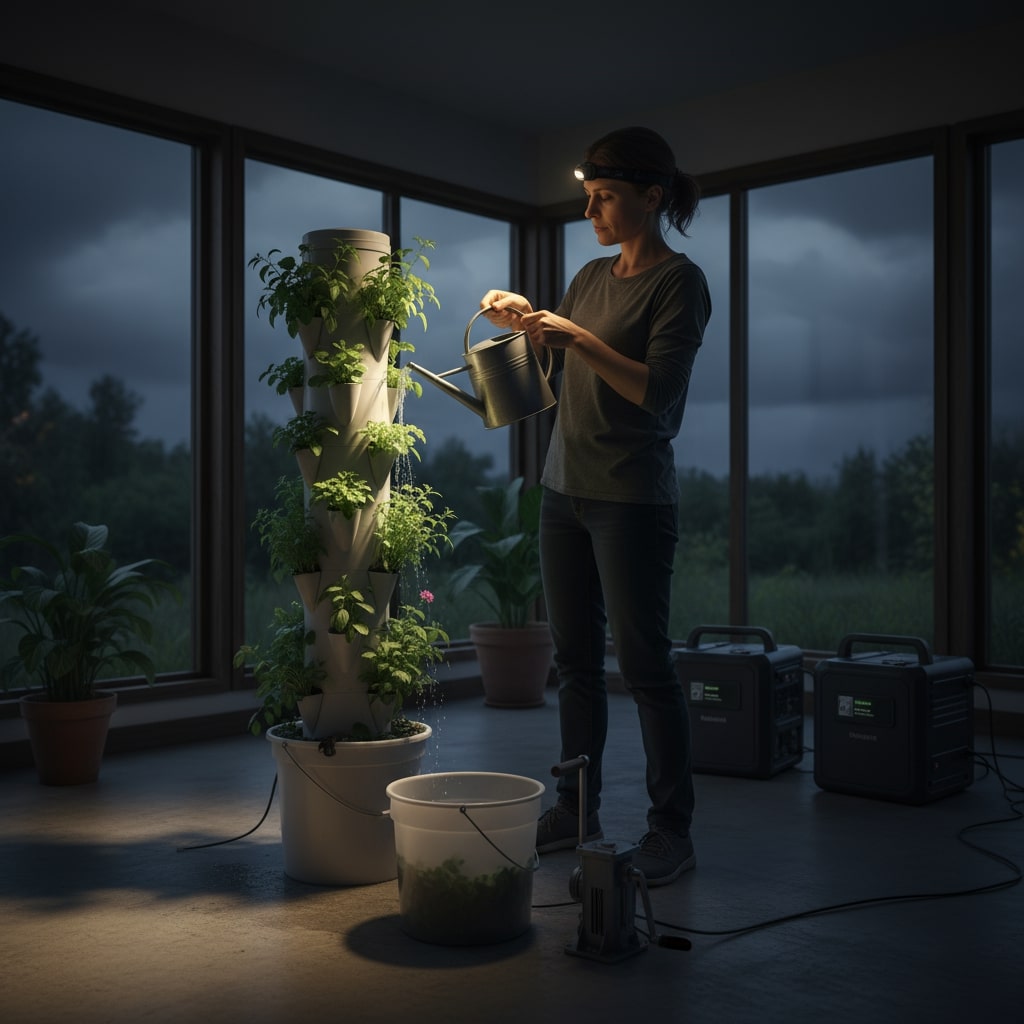
Cost Analysis (DIY vs Readymade)
Here’s a reality check – most Indian families don’t realize they’re spending ₹500-900 monthly on basic herbs and vegetables that could be grown at home for fraction of the cost.
Complete Investment Breakdown
DIY Tower Total Investment:
- Essential materials: ₹2,800-3,500
- Basic tools (if unavailable): ₹600-900
- Seeds and seedlings: ₹200-400
- First month nutrients: ₹150-250
Total first-time cost: ₹3,750-5,050
Monthly Operating Expenses:
- Electricity for pump: ₹40-60 (based on current Indian rates)
- Organic nutrients/fertilizers: ₹100-150
- Replacement seeds: ₹50-100
Total monthly running cost: ₹190-310
Return on Investment Reality Check
Monthly savings from homegrown produce:
- Fresh pudina (4 bunches): ₹80 saved
- Dhania (8 bunches): ₹320 saved
- Curry leaves (daily use): ₹90 saved
- Cherry tomatoes (1 kg monthly): ₹120 saved
- Green chilies (300g monthly): ₹60 saved
Total monthly grocery savings: ₹670-850
Net monthly benefit: ₹670 savings – ₹310 costs = ₹360+ pure profit after initial payback period.
Complete payback timeline: 4,000 ÷ 360 = 11 months for total investment recovery, then continuous savings for years!
Readymade Commercial Systems Comparison
Imported tower systems available in India:
- Basic readymade towers: ₹15,000-25,000
- Premium automated systems: ₹35,000-60,000
- Annual maintenance contracts: ₹3,000-8,000
Payback timeline for commercial systems: 3-6 years minimum
Clear winner: DIY systems achieve complete payback 70% faster while providing total control over your growing environment.
FAQ Section
Q: Can I build a vertical garden tower without using an electric pump?
A: Technically yes, but it requires manual watering 2-3 times daily consistently, which becomes very challenging with busy Indian lifestyles. For reliable results when learning how to build a vertical garden tower, automated timer-pump systems are strongly recommended.
Q: Which herbs grow best in partial shade conditions typical of Indian apartments?
A: Pudina, dhania, and curry leaves can easily handle 4-5 hours of direct sunlight and perform excellently for apartment vertical farming. These work perfectly for east-facing balconies common in Indian residential buildings.
Q: How much water does a tower actually consume daily in Indian climate conditions?
A: Approximately 6-10 liters daily depending on season, plant types, and local humidity levels. This represents 60-70% less water usage than traditional soil gardening methods, making it ideal for balcony gardening ideas India where water conservation is important.
Q: What’s the realistic lifespan of DIY tower in harsh Indian weather conditions?
A: With proper UV-resistant PVC pipes and regular basic maintenance, expect minimum 5-8 years of productive use. My original tower is still thriving after 3 years with only routine care for my DIY vertical garden tower India setup.
Q: Can I successfully grow fruiting vegetables like tomatoes and brinjals in towers?
A: Cherry tomatoes and small chili varieties work excellently as best plants for vertical garden tower options and produce abundant harvests. However, full-size tomatoes and large brinjals are too heavy and space-consuming for typical tower systems.
Q: How do I prevent mosquito breeding in water reservoir during monsoon season?
A: Keep reservoir completely covered with tight-fitting lid and add 2-3 drops of neem oil weekly. The continuous water circulation from pump operation also effectively prevents mosquito breeding in how to grow herbs in small space setups.
Q: Is vertical tower gardening suitable for all Indian cities and climates?
A: Absolutely! I’ve personally helped friends establish successful towers in Delhi, Chennai, Pune, Hyderabad, and Kolkata. The key is adjusting plant selection based on local climate conditions and seasonal variations.
Conclusion with Emotional Push + CTA
Three years ago, I was exactly where you might be right now – frustrated with expensive, low-quality vegetables from crowded markets, dreaming of fresh herbs but convinced my tiny balcony couldn’t support real gardening.
Today, every morning when I step onto my balcony with my chai, I’m greeted by the sight of fresh green leaves reaching toward the sky. When I pluck dhania for lunch or pudina for evening tea, I’m reminded of my grandmother’s village garden where vegetables actually had flavor and nutrition.
But here’s what really changed everything for me: Last month, my 8-year-old nephew visited from Delhi. He was amazed seeing cherry tomatoes growing right outside the kitchen window. He spent an hour carefully picking them, tasting each one, and asking endless questions about how plants grow. That night he told his mother he wanted to “become a farmer like Zaid uncle” when he grows up.
Learning how to build a vertical garden tower isn’t just about saving ₹5,000+ annually on groceries (though that’s pretty fantastic, no?). It’s about:
- Teaching the next generation where real food comes from
- Having genuinely fresh ingredients available 24/7 without market trips
- The deep satisfaction of serving completely homegrown produce to your family
- Creating a peaceful green sanctuary in our increasingly concrete cities
- Taking control over what chemicals do (or don’t) go into your family’s food
Your DIY vertical garden tower India project represents more than just gardening – it’s reclaiming your family’s food security and health independence. Every morning when you see those plants thriving, you’ll remember this exact moment when you decided to change your relationship with food forever.
The only question remaining is: what herb will you grow first to surprise your family?
Ready to join thousands of Indian families already growing their own fresh food? Start building your tower this weekend, and share your first harvest photos with us! I personally respond to every tower builder who tags @FlatGardening on social media with their success stories. 🌱
Printable Step-by-Step Checklist
Pre-Construction Phase:
□ Measure available balcony space and daily sunlight hours
□ Order all materials using affiliate links provided above
□ Gather basic tools: drill, hole saw, measuring tape, marker
□ Plan optimal tower height based on ceiling and space constraints
□ Choose initial plants based on current season and family preferences
□ Check building society rules regarding balcony gardening activities
Construction Phase:
□ Cut PVC pipe to desired length (4-5 feet recommended for apartments)
□ Mark hole positions at precise 8-inch intervals using measuring tape
□ Drill holes at a 15-degree upward angle using a 3-inch hole saw attachment
□ Test-fit all pipe connections and joints before final assembly
□ Set up a water reservoir with a submersible pump and safety features
□ Install and thoroughly test the complete irrigation system for leaks
□ Securely anchor tower structure to wall or railing for monsoon safety
Planting Phase:
□ Soak cocopeat growing medium overnight in large bucket (essential step)
□ Fill net pots with properly prepared, well-draining growing medium
□ Install filled pots securely in tower holes ensuring snug fit
□ Plant chosen herbs/vegetables according to seasonal recommendations
□ Set automated watering timer for 3 daily cycles (morning, afternoon, evening)
□ Install protective measures like mesh covering and shade cloth as needed
Maintenance Setup:
□ Establish daily 5-minute inspection routine for optimal plant health
□ Stock organic fertilizers, neem oil, and basic pest control supplies
□ Plan systematic harvest schedule and succession planting timeline
□ Set up simple record-keeping system for tracking plant performance
□ Prepare comprehensive emergency backup plans for extended power cuts
Written by Zaid Ansari, who transformed his cramped 4×6 Mumbai balcony into a productive green paradise growing fresh herbs year-round. After spending ₹500+ monthly on wilted market vegetables, Zaid learned vertical gardening and now saves ₹2,000+ annually while enjoying the freshest produce. Through FlatGardening.com, he shares practical, tested solutions so every Indian apartment dweller can enjoy homegrown, chemical-free food regardless of space constraints.